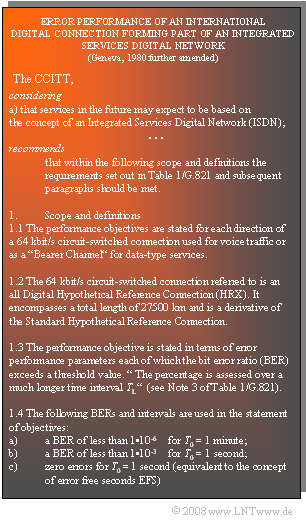Exercise 3.7Z: Error Performance
From LNTwww
Every operator of ISDN systems must comply with certain minimum requirements regarding the bit error rate (BER), which are specified for example in the CCITT Recommendation G.821 under the name "Error Performance".
On the right you can see an excerpt from this recommendation:
- This states, among other things, that – averaged over a sufficiently long time – at least $99.8\%$ of all one-second intervals must have a bit error rate less than $10^{-3}$ (one per thousand).
- For a bit rate of $\text{64 kbit/s}$ this corresponds to the condition that in one second $($and thus for $N = 64\hspace{0.08cm}000$ transmitted symbols$)$ no more than $64$ bit errors may occur:
- $$\rm Pr(\it f \le \rm 64) \ge \rm 0.998.$$
Hints:
- The exercise belongs to the chapter Gaussian distributed random variables.
- Always assume bit error probability $p = 10^{-3}$ for the first three subtasks.
- In addition, throughout the task, let $N = 64\hspace{0.08cm}000$ hold.
- Under certain conditions – which are all fulfilled here – the binomial distribution can be approximated by a Gaussian distribution with equal mean and equal rms.
- Use this approximation for the subtask (4).
Questions
Solution
(1) Both statements are correct:
- The random vairable $f$ defined here is the classical case of a binomially distributed random variable: Sum over $N$ binary values $(0$ or $1)$.
- Because the product $N \cdot p = 64$ and thus is much larger than $1$ ,
- the binomial distribution can be approximated with good approximation by a Poisson distribution with rate ${\it \lambda} = 64$ .
(2) The mean is obtained as $m_f = N \cdot p \hspace{0.15cm}\underline{= 64}$ regardless of whether one assumes the binomial– or the Poisson distribution.
(3) For the rms one obtains
- $$\it \sigma_f=\rm\sqrt{\rm 64000\cdot 10^{-3}\cdot 0.999}\hspace{0.15cm}\underline{\approx\sqrt{64}=8}.$$
- The error by applying Poissonl distribution instead of binomial distribution here is smaller than $0.05\%$.
(4) For a Gaussian random variable $f$ with mean $m_f {= 64}$ the probability ${\rm Pr}(f \le 64) \hspace{0.15cm}\underline{\approx 50\%}$. Note:
- For a continuous random size, the probability would be exactly $50\%$.
- Since $f$ can only take integer values, it is slightly larger here.
(5) With $\lambda = N \cdot p$ the corresponding condition is:
- $$\rm Q\big (\frac{\rm 64-\it \lambda}{\sqrt{\it \lambda}} \big )\le \rm 0.002\hspace{0.5cm}\rm or.\hspace{0.5cm}\frac{\rm 64-\it \lambda}{\sqrt{\it \lambda}}>\rm 2.9.$$
- The maximum value of $\lambda$ can be determined according to the following equation:
- $$ \lambda+\rm 2.9\cdot\sqrt{\it\lambda}-\rm 64 = \rm 0.$$
- The solution of this quadratic equation is thus:
- $$\sqrt{\it \lambda}=\frac{\rm -2.9\pm\rm\sqrt{\rm 8.41+256}}{\rm 2}=\rm 6.68 \hspace{0.5cm}\rightarrow \hspace{0.5cm} \lambda = 44.6 \hspace{0.5cm}\Rightarrow \hspace{0.5cm} {\it p}_\text{B, max}= \frac{44.6}{64000} \hspace{0.15cm}\underline{\approx 0.069\%}.$$
- The second solution is negative and need not be considered further.
